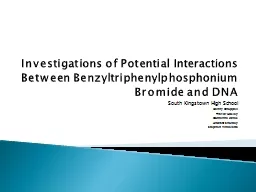

Benzyltriphenylphosphonium Bromide and DNA South Kingstown High School Kenny Chappell Trevor Hosley Catherine Jones Andrew Sharkey Stephen Vincelette BzTPPBr Melting Point 295C Appearance Offwhite solid ID: 603953
Download Presentation The PPT/PDF document "Investigations of Potential Interactions..." is the property of its rightful owner. Permission is granted to download and print the materials on this web site for personal, non-commercial use only, and to display it on your personal computer provided you do not modify the materials and that you retain all copyright notices contained in the materials. By downloading content from our website, you accept the terms of this agreement.
Slide1
Investigations of Potential Interactions Between Benzyltriphenylphosphonium Bromide and DNA
South Kingstown High School
Kenny Chappell
Trevor
Hosley
Catherine Jones
Andrew Sharkey
Stephen
VinceletteSlide2
BzTPPBr
Melting Point: 295°C
Appearance: Off-white solid
Molecular Formula: C
25
H
22
PBr
Molecular Weight: 433.32
amu
Solubility: Reacts
Contact with water liberates toxic gasSlide3
Phosphonium Salt UsesPhase transfer catalystsTumor imagingAntioxidant
Suppress reproduction of influenza virus A (H2N2)Slide4Slide5Slide6Slide7Slide8
Plasmid Electrophoresis
Lane 1: Cut DNA without binding agent
Lane 2: Cut DNA with binding agent
Lane 3: Native DNA without binding agent
Lane 4: Native DNA with binding agent
Lane 5: Ladder
Approximate Number of Base Pairs:
Lane 1: 1490
bp
Lane 2: 1430
bp
Lane 3: 1500
bp
, 1290
bp
Lane 4: 1500
bp
, 1290
bpSlide9
Approximate Number of Base Pairs:
E: 1390
bp
EB10: 1400
bp
X: 1430
bp
, 1230
bp
XB10: 1480
bp
, 1250
bp
EB15: 1480
bp
XB15: 1500
bp
, 1270
bpSlide10
Plasmid Electrophoresis with Alternate Concentration
Lane 1: Cut DNA without binding agent
Lane 2: Cut DNA with 10 µl binding agent
Lane 3: Native DNA without binding agent
Lane 4: Native DNA with µl binding agent
Lane 5: Ladder
Lane 6: Cut DNA with 15 µl of binding agent
Lane 7: Native DNA with 15 µl of binding agent
Approximate Number of Base Pairs:
Lane 1: 1490
bp
Lane 2: 1430
bp
Lane 3: 1500
bp
, 1290
bp
Lane 5: 1480
bp
, 1250
bp
Lane 6: 1480
bp
Lane 7: 1500
bp
, 1270
bpSlide11
Plasmid Electrophoresis with High
Concentrations of Binding Agent
Lanes 1 and 2: Cut DNA with 25 µl of binding agent
Lanes 3 and 4: Cut DNA with 50 µl of binding agent
Lanes 5 and 6: Cut DNA with 100 µl of binding agentsSlide12
Distance and Energy Levels - Intercolation
Distance (Å)
Energy (kcal/mol)
Unoptimized
11.845
-310.678
Optimized
11.769
-344.349
Unoptimized
9.257
-344.414
Optimized
9.208
-365.218
Unoptimized
5.492
-366.421
Optimized
5.482
382.605
Unoptimized
4.32476847589.71Optimized4.62-386.675Unoptimized1.0515.42756E+13Optimized3.4211107.211Unoptimized1.3211.49461E+12Optimized2.324-155.291Slide13
Distance and Energy Levels -
Major
Groove
Distance (Å)
Energy (kcal/mol)
Unoptimized
21.887
12408.013
Optimized
22.742
-84.924
Unoptimized
15.723
-85.325
Optimized
16.147
-102.741
Unoptimized
8.029
-92.439
Optimized
8.036
-143.485Unoptimized1.0276830.024Optimized2.308-175.409Unoptimized0.545960436.167Optimized2.1-169.831Slide14
Distance and Energy Levels -
Minor Groove
Distance (Å)
Energy (kcal/mol)
Unoptimized
11.546
24827.785
Optimized
11.608
-85.585
Unoptimized
4.962
-86.042
Optimized
5.063
-102.269
Unoptimized
1.544
204.203
Optimized
2.605
-109.575
Unoptimized0.7791112801.929Optimized2.882-122.368Slide15
DiscussionChange in melting point of approximately 2.5°CElectrophoresis does not show binding
Hyperchem
shows unzipping when molecule is placed in minor groove
Electrophoresis
with cut genomic DNA
More systematic melting point study at different concentrations
Use marker gene to label moleculeSlide16
Thank you Dr.
Tiskus
and Dr. Williams